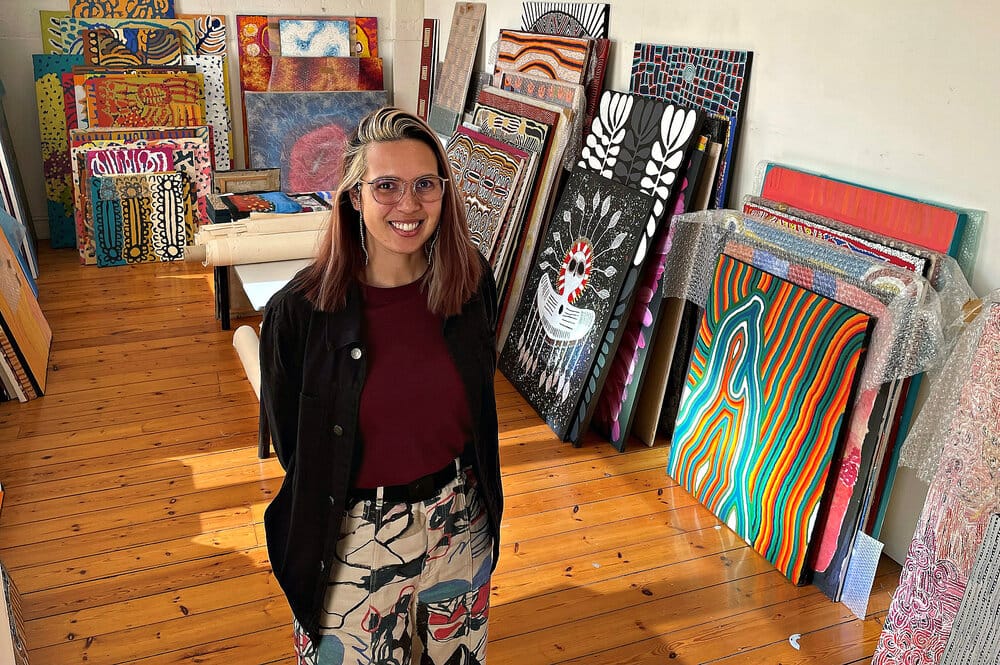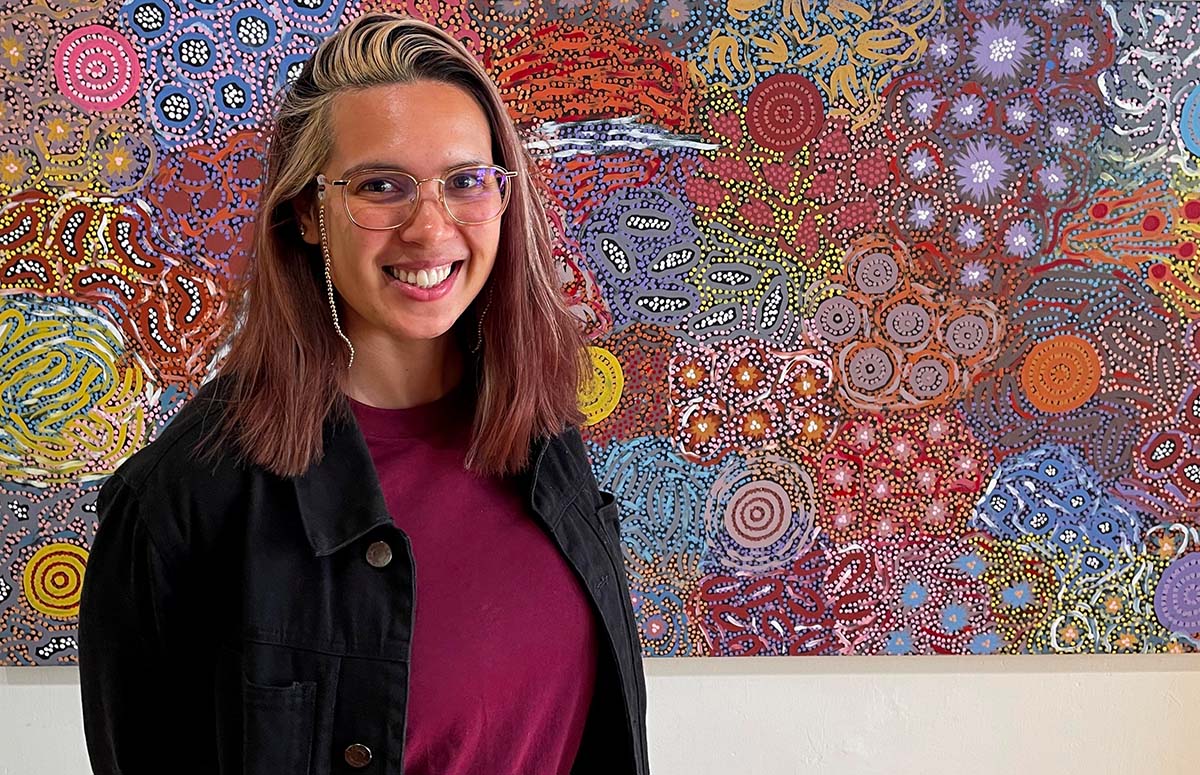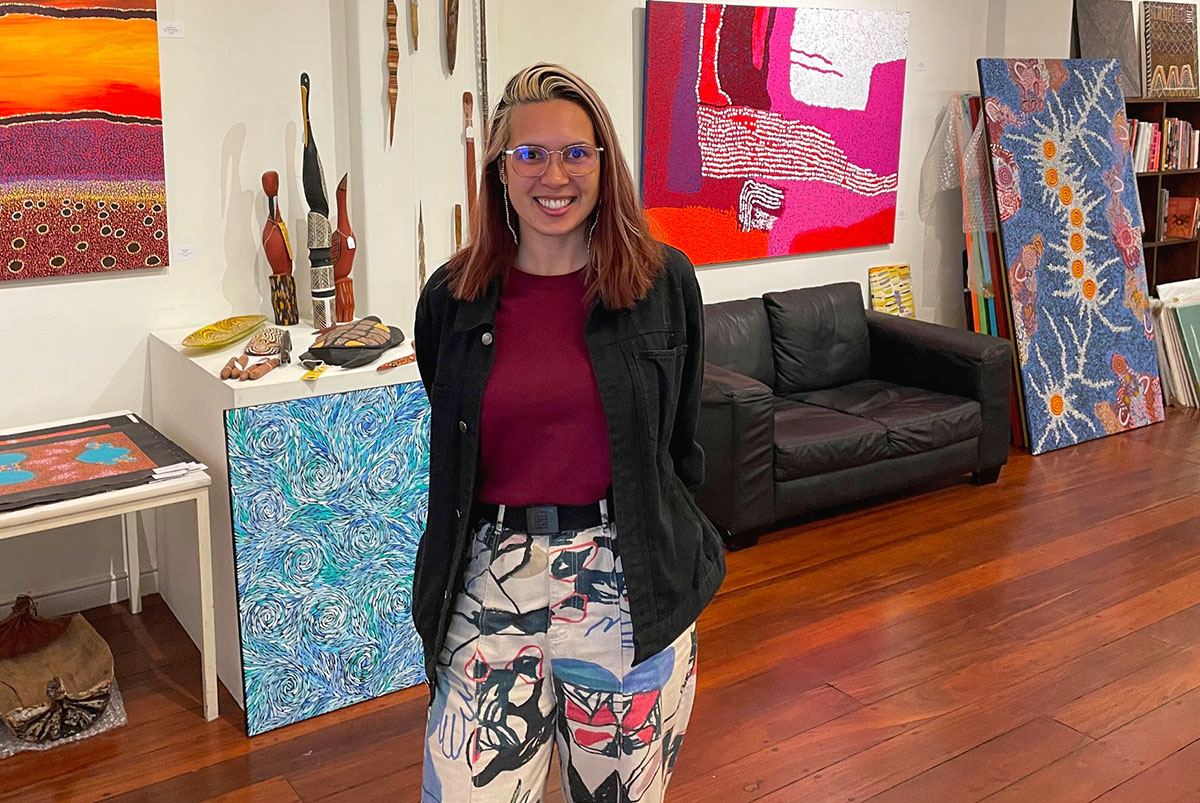Stories Of Country, Stories of Connection
Jade Dolman is a Perth based mural artist. Here she discusses her work, her growing cultural engagement and her plans for the future.

How do you introduce yourself now when you meet people?
Kaya, ngany kwerl Jade, which means my name is Jade. I am Whadjuk/Balladong Bibbulmun Yorga and Arrernte woman. I am a full-time mural artist based in Boorloo, Perth.
Can you describe the type of mural projects you work on?
I work on large-scale exterior and interior walls as my canvases. The bigger the better. Most of my clients are companies or corporations. I've recently done work at shopping centres, cafes and restaurants.
Can I ask you what input do your clients have? How does it work, do you consult about the imagery?
I prefer the type of projects where I have full-creative freedom. That's something I've learned over the years. That's quite a big part of how much I would enjoy a project. I like being able to have full-creative freedom and speaking to my family to see what type of stories come up that are relevant to the area where the mural is situated. Then, I pay attention to the way I feel emotionally about that information. All that influences the way that I approach the design of the mural.
How do you see the local art scene changing in relation to the work that you do?
There's definitely a lot more Aboriginal mural artists now than there was before. I think the demand has grown massively because of reconciliation. Everyone's on board with that train at the moment. I hope it lasts and it's not just at the moment, because I really feel like there's a really strong movement towards reconciliation from Indigenous and Non-Indigenous people. I think art is such a powerful tool to be able to help in that process.
COVID has been a factor around art and artists over the last two years. Did it have an impact on you?
I think I was very lucky because COVID brought a lot more work opportunities for me. Councils were restricted in what they could spend their budget on. A lot of public art and cultural projects were prioritised because there was the budget for it. My bookings were pretty full for a couple of years. I think it probably was one of my busiest times since starting my business.
What do you like to do and why?
At the moment, my favourite way to paint is while I'm listening to storytelling or being surrounded by Elders. That's when I have the most inspiration and the most art comes out. It just flows a lot better when I'm around my own mob. Whereas being on my own in the studio, I do struggle a bit.
How do the mural projects work? Do you have a team that you work with?
Most of the projects I do on my own, but I get friends in, other artists, to come help me if it's a big project. They also keep me company so it's a lot more fun.
There's this movement called Dandjoo Koorliny, an organisation. Dandjoo Koorliny, which means walking together. It's starting conversations about reconciliation and how we want the future to look before we get to that point. It's led by a group of Elders and every conversation is visually recorded through artists. I'm one of the artists who are engaged to record all these conversations based on the feeling of the room, the mood of the conversations, the seriousness of it, how I'm responding to it. I create artworks for every time that there are conversations or meetings. That's kept as a visual record so that when we look back we can see how it changes over time.
I hadn't done painting like that before, live painting and live recording. You don't know how it's going to turn out every time. You have to disconnect yourself from thinking too much. So you just let it flow and you just choose the colours and you just use the techniques that feel right. I've really enjoyed that process and I think that's actually my favourite way to paint at the moment. All the Dandjoo Koorliny projects make me feel really refreshed, alive, grounded and inspired.
It is very different from university, isn't it?
It is. It's so different. They do similar things. They're both teaching and passing down knowledge. Both are having really important conversations, helping you figure out how you feel about things, and really connecting you back to yourself and to country. This is not just for Aboriginal people, for non-Aboriginal people as well. Both are helping you to figure out your role in reconciliation.
What advice would you have for young artist starting out? Help me understand some of the lessons that you've learned along the way?
-
Make sure you have very transparent communication with clients from the very beginning.
-
It's also never too late to pull out of a project if you have a gut feeling that it's not right.
-
Be supported by contracts as much as possible and seek out your own information about copyright and licensing, otherwise it will come back and bite you at some point.
-
Be very sure about the cultural knowledge that you are sharing in your projects and make sure you have cultural permission to be sharing those.

We know that Nyoongar was once a phrase that people used to refer to and honour the people of this area. You're using slight variations on that, so could you talk me through the variations?
It's encouraged to use Bibbulman rather than Nyoongar. Nyoongar refers to the word man and this is a matriarchal country. So it's preferable to use Bibbulman. There's different Nyoongar nations or Bibbulman nations.
There's 14 different Bibbulman nations. Whadjuk is just the area of Perth, of Boorloo, and Balladong is the other nation I'm connected to, which is York and Northern area. The 14 Noongar nations are Amangu, Ballardong, Yued, Kaneang, Koreng, Mineng, Njakinjaki, Njunga, Pibelmen, Pindjarup, Wadandi, Whadjuk, Wiilman and Wudjari.
Where would you like to see your art go? Could you ever imagine having a solo show here?
Oh, I would love to, one day. I am actually planning to take 2023 off to figure out what I would paint if there was no client in the picture. So I'm really looking forward to it. I’m just organising some studio spaces at the moment. I might possibly have rotating studios with the intention to work towards my first solo show.
You've developed a new process in culturally referencing your art. Can you explain some more about that to me?
At the very beginning of my concept process, I meet with my family and speak to them about the areas where the murals are located. They are just a world of knowledge about Nyoongar/Bibbulmun Country. There's always been a lot of things I've learned about those areas that I didn't know before, especially if it's near wetlands, very significant, or hills, which are really important. I include some of that work in there.
One project I did in the city recently was just off of William Street. This area was once two major lakes, right where there is the CBD. My painting was to honour the lakes that used to be there that are no longer there. I feel like it's quite sad and quite a strong mural, because it's not all bright and happy. The mural is about this is what was here, and this is what's happened to that place. It’s about the impact on the environment, ecosystem, and Nyoongar/Bibbulmun people, culturally, as well. I think it's really important to highlight those things. I've been doing that a lot more with my art lately, acknowledging what used to be there and the impact that colonisation has had on the land.
You're like a visual historian?
Yeah. Very much.
How does a Non-Indigenous person assist in the reconciliation process, meaningfully, in their local community? What's valuable? What's not valuable?
I think, knowing that all of the information is out there. It's up to the individual to listen and to put themselves in positions where they can understand more without ever speaking on behalf of Aboriginal people. Instead, help give them a platform to use their own voice in every aspect of life.

